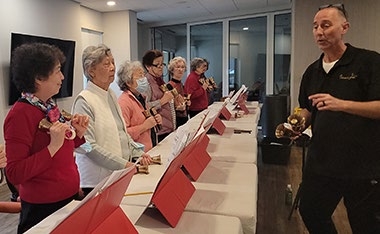Music is an integral part of the human experience. For some, it represents a cultural identification, for others an artistic and emotional expression or release, but for just about everyone, it brings pleasure. This is evident from studies that show how listening to music can release dopamine in the brain, which helps elevate our mood. This effect is intensified when someone is actively playing a musical instrument.
Because playing a musical instrument affects several different portions of the brain simultaneously, it has been referred to as a ‘total brain-workout.’ For those just learning how to read music, it is truly like learning a new language. Music has its own notation (pardon the pun), syntax, and structure. And while learning to read music does have its challenges, the residents at Hunters Woods have shown it is never too late to take this on.
Music To Free’s Handbell program began at Hunters Woods in July of 2021 as the pandemic started to loosen its grip, and residents could once again meet as a group. At the start, no one in the group had ever played a musical instrument and no one knew how to read music. Now, most of the participants understand the fundamentals of reading handbell music and, specifically, finding their parts to play in a musical score.
Why handbells? Handbells, as an instrument, offer many advantages for new musicians, especially those with limited mobility. Some of these advantages include:
• The higher-pitched bells are light enough for just about anyone to hold and play. • The stroke used to ring a handbell is controlled and gentle; even for those with a limited range of motion. • Ringers develop their hand-eye coordination as well as motor control. • Ringers also develop bi-manual coordination (doing different things with each hand simultaneously). • It does not require the manual dexterity necessary to play other instruments such as the piano, flute, sax, violin, etc. • It exercises and stimulates the brain. • It is a social activity. • It is FUN!
When playing a full 5 octaves of handbells, there are 61 bells on the table, but they represent ONE instrument. There are ways for just a single person to play those bells, but typically you would have a group of 12 or more people. It’s similar to having 12 people play the piano and everyone gets to play only 2 notes. You have to work together as a group in order to play a piece of music. During COVID, having your handbell- family to see every week was important and something the ringers looked forward to. Even now with COVID somewhat under control, they still look forward to the weekly rehearsals as a time to learn, relax, socialize, and share an experience with others. There is a weekly reason to get out of their apartment and be with others.
Our name, Music To Free, comes from our founder’s own experience when playing a musical instrument. “While playing, all of the other noise in my mind is pushed aside and I’m free to concentrate solely on the task at hand, making music.” Alan Payne Executive Director, Music To Free If you are interested in starting a handbell program or joining one of Alan’s existing handbell ensembles for beginning, intermediate, or advanced ringers, please feel free to email him or visit the website.






Leave a Reply